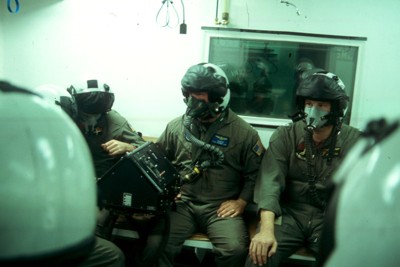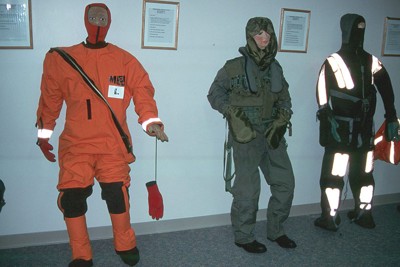|
Located in the US Navy region North West, is Naval Air Station Whidbey Island. Home to several EA-6B, and P-3 Orion units, NASWI also houses the Aviation Survival Training Centre ASTC. Flightgear Online was shown around the Naval Air Station and its units.
Prowlers
We started the visit with a briefing at VAQ 138 "Yellow Jackets", one of the resident EA-6B units, flying the Block 89 EFIS Prowler. Here we got a first look at their flight gear and aircraft.
The EA-6B pilots were fitted with the following flight gear during our visit in may 2001. CWU-27/P flightsuit, HGU-68(V)/P helmet with MBU-14(B)1/P mask ,a CRU-79 regulator and the AIRSAVE vest combined with LPU-33/P life preserver. The g-suit is allready the CSU-13B/P now in use as replacement for the CSU-15/P.

Orions
Unfortunatly the Orion community was off limits during our visit, due to the sensitive nature of the EP-3E ARIES II Orions from VQ-1 "World Watchers".
The day before our visit, the crew of the VQ-1 Orion that landed in China returned home.
ASTC
ASTC WHidbey Island provides aviation survival and safety training for Navy and Marine Corps Aviation. This Training includes classroom or squadron lectures, simulator devices and a curriculum that emphasizes hands-on exposure to survival skills. They provide indoctrination, midshipman, and refresher training in aviation physiology, sensory physiology, stress factors, acceleration, low pressure chamber operations, oxygen breathing equipment, aircrew personal survival/protective equipment, and emergency egress.
ASTC also gives NATOPS approved water survival curriculum, which encompasses classroom lectures, extended sea survival, survival swimming, over water parachuting, underwater egress, life raft organization, helicopter rescue and use of survival items.
Pressure Chamber and class room.
During our visit the pressure chamber was in full use. Several naval aviators were undergoing training. They had to do several test during a 4 minute period without wearing a mask. After that 100% oxygen was given. The aviators were wearing the HGU-86/P with the MBU-12/P type mask with a naval commcord but not the AM-7067/A delta block amplifier.

The class room had several flight gear items on display. For instance a complete current setup and a CWU-62A/P suit, CWU-60/P and the CWU-9/P. 
The CWU-62A/P is part of the A/P22P-6(V)2 and the A/P22P-6A(V)2 antiexposure assemblies. These are continuous wear assemblies designed to keep the wearer dry. The complete assemblies provide protection from the thermal effects of cold water immersion in the event of emergency overwater bailout. The assemblies differ only in the type of liner that is worn. The A/P22P-6(V)2 assembly uses the CWU-23/P liner, and the A/P22P-6A(V)2 assembly uses the CWU-72P liner.
The CWU-60/P is a one piece coverall constructed of a gas expanded,
closed cell neoprene foam body, mittens, boots and face seal, an aramid
laminated microporous polytetrafluoroethylene (PTFE) hood, and neoprene
coated cotton gloves. These neoprene gloves are located adjacent to the
mittens and provide dexterity when needed. The outside of the coverall
also has removable reflective tape to aid in search and rescue operations. Two types of reflective tape are provided: fluorescent
red-orange for maximum daytime detection and bright silver for maximum nighttime detection and enables the aircrewmember to remove the reflective tape if evasion is
desired. The coverall also includes ankle and waist straps and an entrance slide fastener (waterproof zipper) which extends from the crotch up the center
front. The suit also features a recovery harness which includes a gated D-ring
providing the capability for helicopter pick up in case the survival vest
is not being worn at the time of rescue. A pocket is located on the right thigh
of the coverall contains the HGU-32/P anti-exposure hood.
The CWU-9/P is an under garment setup. In the hallway a mannequin is displayed with the older type flight gear with HGU-43/P? helmet.

Other training
In the ASTC complex, parachute jumps could be simulated as well as underwater escape manouvres in the pool. Even the ejection seat sequence could be trained. The ejection seat used in the EA-6B is the Martin Baker Mk. GRU-7EA. This seat is a late model Mk. 7 family member. It is the direct decendant of the GRU-5 seat used in the early A-6 Intruder aircraft. That seat became the GRU-7 seat (with many modifications), which was followed by the GRUEA-7 (GRU-7EA) for the stretched EA-6 Prowler aircraft. 
The ASTC provides a complete training program covering all egress aspects.
We like to thank the men and women serving on Naval Air Station Whidbey Island for their help in creating this article. |